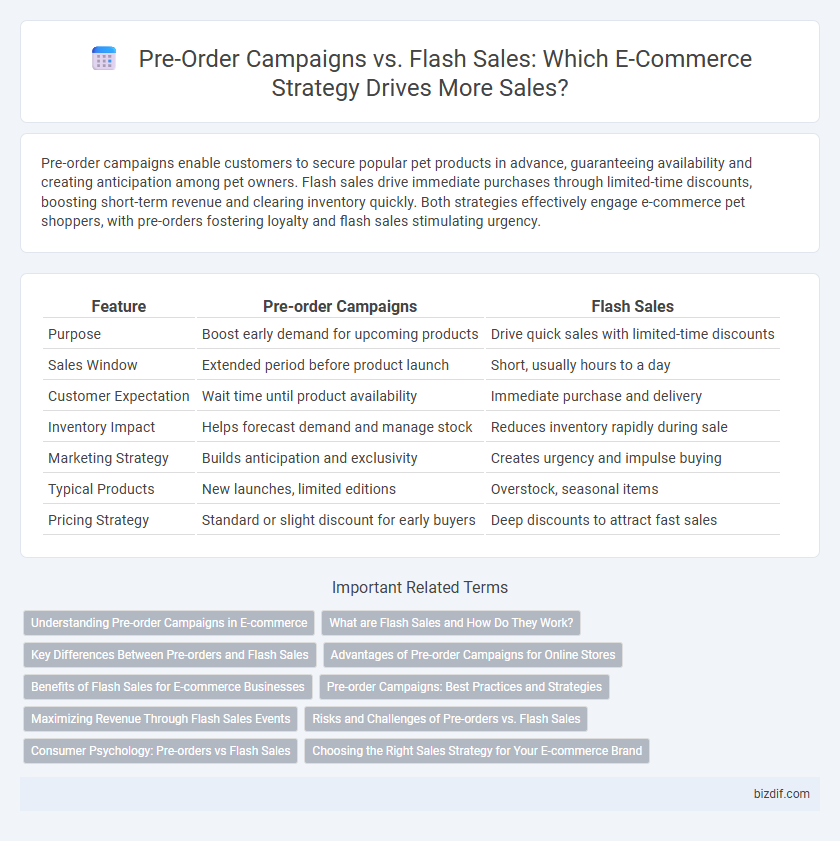Pre-order campaigns enable customers to secure popular pet products in advance, guaranteeing availability and creating anticipation among pet owners. Flash sales drive immediate purchases through limited-time discounts, boosting short-term revenue and clearing inventory quickly. Both strategies effectively engage e-commerce pet shoppers, with pre-orders fostering loyalty and flash sales stimulating urgency.
Table of Comparison
| Feature | Pre-order Campaigns | Flash Sales |
|---|---|---|
| Purpose | Boost early demand for upcoming products | Drive quick sales with limited-time discounts |
| Sales Window | Extended period before product launch | Short, usually hours to a day |
| Customer Expectation | Wait time until product availability | Immediate purchase and delivery |
| Inventory Impact | Helps forecast demand and manage stock | Reduces inventory rapidly during sale |
| Marketing Strategy | Builds anticipation and exclusivity | Creates urgency and impulse buying |
| Typical Products | New launches, limited editions | Overstock, seasonal items |
| Pricing Strategy | Standard or slight discount for early buyers | Deep discounts to attract fast sales |
Understanding Pre-order Campaigns in E-commerce
Pre-order campaigns in e-commerce allow customers to reserve products before official release, generating early sales data and forecasting demand accurately. These campaigns improve inventory management by reducing the risk of overstock or stockouts, while also creating anticipation and engagement around new product launches. Retailers leverage pre-order insights to optimize marketing strategies and ensure timely product fulfillment, enhancing overall customer satisfaction and loyalty.
What are Flash Sales and How Do They Work?
Flash sales are limited-time promotional events where products are offered at significantly discounted prices to create urgency and boost immediate sales. These sales typically last from a few minutes to a few hours and rely on scarcity and time-sensitive offers to encourage quick purchases. Ecommerce platforms implement flash sales through countdown timers and inventory limits, driving impulse buying and increasing customer engagement.
Key Differences Between Pre-orders and Flash Sales
Pre-order campaigns enable customers to secure products before official release dates, often driving early demand and forecasting sales, while flash sales offer limited-time discounts on existing inventory to rapidly boost revenue and clear stock. Pre-orders emphasize planned customer commitment and inventory management, whereas flash sales capitalize on urgency and impulsive buying behavior. Understanding these distinctions helps e-commerce businesses strategize marketing, inventory control, and customer engagement effectively.
Advantages of Pre-order Campaigns for Online Stores
Pre-order campaigns enable online stores to gauge product demand accurately before committing to inventory, reducing the risk of overstock or stockouts. These campaigns enhance cash flow by securing early payments and building customer anticipation, resulting in stronger purchase intent and higher conversion rates. Furthermore, pre-orders provide valuable consumer insights and allow for better production planning, optimizing supply chain efficiency and minimizing marketing costs.
Benefits of Flash Sales for E-commerce Businesses
Flash sales create urgency by offering limited-time discounts, driving immediate consumer purchases and boosting short-term revenue for e-commerce businesses. They increase website traffic and enhance brand visibility by attracting bargain hunters and new customers through time-sensitive promotions. Flash sales also help manage inventory efficiently by quickly moving surplus stock without long-term discounting risks.
Pre-order Campaigns: Best Practices and Strategies
Pre-order campaigns optimize inventory management and create customer anticipation by allowing shoppers to reserve products before official release, often leading to higher conversion rates and better cash flow forecasting. Implementing clear communication on estimated delivery times, offering exclusive incentives like early-bird discounts or limited-edition products, and leveraging social media channels for targeted promotion significantly enhance pre-order success. Prioritizing seamless user experience through straightforward checkout processes and transparent updates builds trust and increases customer loyalty in e-commerce pre-order strategies.
Maximizing Revenue Through Flash Sales Events
Flash sales events generate rapid revenue spikes by creating urgency and encouraging impulse purchases from a broad customer base. Limited-time offers leverage scarcity and time constraints to boost conversion rates significantly compared to pre-order campaigns, which rely on future product availability. Retailers optimize inventory turnover and capitalize on immediate consumer demand through targeted marketing and exclusive flash sale discounts.
Risks and Challenges of Pre-orders vs. Flash Sales
Pre-order campaigns risk inventory mismanagement and customer dissatisfaction due to delayed product availability, impacting brand trust and sales forecasting accuracy. Flash sales present challenges like server overloads, stock depletion, and potential profit margin erosion caused by steep discounts and high demand spikes. Both strategies require careful logistical planning and real-time data analysis to mitigate operational risks and optimize customer experience.
Consumer Psychology: Pre-orders vs Flash Sales
Pre-order campaigns leverage consumer anticipation, creating a sense of exclusivity and commitment that enhances perceived product value and reduces purchase hesitation. Flash sales exploit urgency and scarcity, triggering impulsive buying behavior driven by fear of missing out (FOMO). Both tactics activate distinct psychological triggers: pre-orders foster planned ownership and loyalty, while flash sales stimulate immediate gratification and high transaction volumes.
Choosing the Right Sales Strategy for Your E-commerce Brand
Pre-order campaigns build anticipation and secure early revenue by allowing customers to reserve products before launch, ideal for new or limited-edition items. Flash sales create urgency through steep discounts for a short period, driving quick spikes in traffic and clearing inventory rapidly. Selecting between pre-orders and flash sales depends on your brand's goals--whether prioritizing demand forecasting and customer engagement or maximizing immediate sales velocity.
Pre-order Campaigns vs Flash Sales Infographic

 bizdif.com
bizdif.com